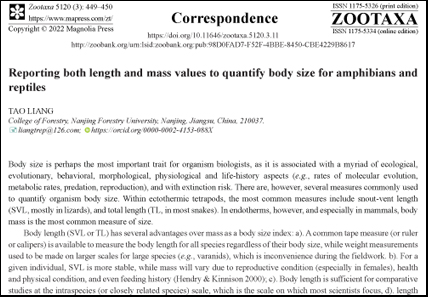Abstract
Body size is perhaps the most important trait for organism biologists, as it is associated with a myriad of ecological, evolutionary, behavioral, morphological, physiological and life-history aspects (e.g., rates of molecular evolution, metabolic rates, predation, reproduction), and with extinction risk. There are, however, several measures commonly used to quantify organism body size. Within ectothermic tetrapods, the most common measures include snout-vent length (SVL, mostly in lizards), and total length (TL, in most snakes). In endotherms, however, and especially in mammals, body mass is the most common measure of size.
References
Bergmann, C. (1847) Uber die Verhaltnisse der Warmeokonomie der Thiere zu ihrer Grosse. Göttinger Studien, 3, 595–708.
Deichmann, J.L., Jeff, B. & Williamson, G.B. (2009) Anuran artifacts of preservation: 27 years later. Phyllomedusa: Journal of Herpetology, 8, 51–58. https://doi.org/10.11606/issn.2316-9079.v8i1p51-58
Feldman, A. & Meiri, S. (2013) Length–mass allometry in snakes. Biological Journal of the Linnean Society, 108, 161–172. https://doi.org/10.1111/j.1095-8312.2012.02001.x
Feldman, A., Sabath, N., Pyron, R.A., Mayrose, I. & Meiri, S. (2016) Body sizes and diversification rates of lizards, snakes, amphisbaenians and the tuatara. Global Ecology and Biogeography, 25, 187–197. https://doi.org/10.1111/geb.12398
Gumbs, R., Gray, C.L., Böhm, M., Hoffmann, M., Grenyer, R., Jetz, W., Meiri, S., Roll, U., Owen, N.R. & Rosindell, J. (2020) Global priorities for conservation of reptilian phylogenetic diversity in the face of human impacts. Nature Communications, 11, 2616. https://doi.org/10.1038/s41467-020-16410-6
Hendry, A.P. & Kinnison, M.T. (2000) Pattern and Process in Macroecology. Blackwell Publishing, UK, 201pp.
Meiri, S. (2010) Length–weight allometries in lizards. Journal of Zoology, 281, 218–226. https://doi.org/10.1111/j.1469-7998.2010.00696.x
Murali, G., Caetano, G.H.d.O., Barki, G., Meiri, S. & Roll, U.R. (2022) Emphasizing declining populations in the Living Planet Report. Nature, 601, E20–E24. https://doi.org/10.1038/s41586-020-2920-6
Roll, U., Feldman, A., Novosolov, M., Allison, A., Bauer, A.M., Bernard, R., Böhm, M., Castro-Herrera, F., Chirio, L., Collen, B., Colli, G.R., Dabool, L., Das, I., Doan, T.M., Grismer, L.L., Hoogmoed, M., Itescu, Y., Kraus, F., LeBreton, M., Lewin, A., Martins, M., Maza, E., Meirte, D., Nagy, Z.T., Nogueira, C.d.C., Pauwels, O.S.G., Pincheira-Donoso, D., Powney, G.D., Sindaco, R., Tallowin, O.J.S., Torres-Carvajal, O., Trape, J., Vidan, E., Uetz, P., Wagner, P., Wang, Y., Orme, C.D.L., Grenyer, R. & Meiri, S. (2017) The global distribution of tetrapods reveals a need for targeted reptile conservation. Nature ecology & evolution, 1, 1677–1682.
Santini, L., Benítez-López, A., Ficetola, G.F. & Huijbregts, M.A.J. (2017) Length-Mass allometries in Amphibians. Integrative Zoology, 13, 36–45. https://doi.org/10.1111/1749-4877.12268
Scott, N.J. & Aquino-shuster, A.L. (1989) The effects of freezing on formalin preservation of specimens of frogs and snakes. Collection Forum, 53, 41–46.
Shu, G., Gong, Y., Xie, F., Wu, N.C. & Li, C. (2017) Effects of long-term preservation on amphibian body conditions: implications for historical morphological research. PeerJ, 5, e3805. https://doi.org/10.7717/peerj.3805
Speakman, J.R. (2005) Body size, energy metabolism and lifespan. Journal of Experimental Biology, 208, 1717–1730. https://doi.org/10.1242/jeb.01556


